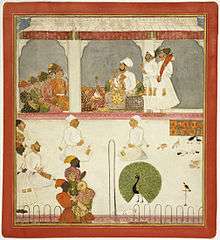Abhai Singh of Marwar
| Maharaja Abhai Singh | |
|---|---|
| Maharaja of the Jodhpur | |
 | |
| Tenure | 24 June 1724 – 18 June 1749 |
| Coronation | 17 July 1724, Delhi |
| Born |
7 November 1702 Meherangarh, Jodhpur |
| Died |
18 June 1749 Ajmer |
| Father | Ajit Singh |
| Religion | Hinduism |
Maharaja Abhai Singh (7 November 1702 - 18 June 1749) was the Raja of Marwar (Jodhpur) Kingdom (r. 24 June 1724 – 18 June 1749).[1][2]
Coronation

Abhai Singh was crowned on the death of this father Maharaja Ajit Singh who himself was killed by a conspiracy of Abhai Singh and Bakhth Singh. He was nonetheless as fearless as his father.
March against Sarbalund
The Padshah was distraught by the news of revolt of Sarbalund but no one in his court dared fight against Sarbalund. When an open challenge was made in court, only Maharaja Abhai Singh took the bida. On his way to Ahmedabad, Abhai first met the Jaipur prince at Pushkar. Abhai Singh took route to Sirohi whose king in fear of desolation against such a big Marwar Army, presented his daughter in marriage to Abhi Singh, Ram singh was scion born of this wedlock.[3]
Battle of Ahmedabad against Sarbaland
The Battle with Sarbuland:[4][5] Sarbuland's plans of defense are minutely detailed. At each gate he posted two thousand men and five guns manned by Europeans of whom he had a body of musketeers round his person. The cannonade had been kept up three days on both sides in which the son of Sarbuland was killed. At length Bakhth Singh led the storm when all the ots and awaits performed prodigies of valour. The Champawat Kushal Singh was the first to be carried to the immortal abode but though the sun stood still to see the deeds of the son of Harnath we cannot particularize the bard's catalogue of heroes transferred to Suryaloka. 3 on this day when the best blood of Rajputana was shed on the walls of Ahmadabad Both the princely brothers had their share in the play of swords and each slew more than one leader of note Amra who had so often defended Ajmer slew five chiefs of the grades of two and three thousand horse.[6]
The princes under Maharaja Abhai Singh
One hundred and twenty of Abhai Singh's chieftains of note with five hundred horse were slain and seven hundred wounded. The next morning Sarbuland surrendered with all his effects. He was escorted towards Agra his wounded Moguls dying at every stage but the soul of the Fearless was sad at the loss of his kin. Abhai Singh of Marwar now ruled over the seventeen 17 thousand towns of Gujarat and the nine thousand of Marwar besides one thousand elsewhere. The princes of Idar, of Bhuj, of Parkar, of Sind and of Sirohi, the Chalukya Ran of Fatehpur, Jhunjunu, Jaisalmer, Nagor, Dungarpur, Banswara, Lunawara, Halwad, every morning bowed the head to Abhai Singh of Marwar, Thus in the enlightened half of the moon on the victorious tenth VS 1787 / AD 1731 the day on which Ramachandra captured Lanka the war against Sarbuland an Omrah lord of twelve thousand was concluded.[7]
The Champawats bore the brunt and lost Karan of Pali, Kishan Singh of Sandri, Gordhan of Jalor and Kalyan. The Kumpawats lost also several leaders of clans as Narsingh, Surtaan Singh, Padma son of Durjan. The Jodha tribe lost three leaders namely Hayatmall, Ghuman and Jogidas. The brave Mertias also lost three Bhum Singh, Kushal Singh and Gulab son of Hathi. The other chieftains the Jadons, the Sonigiras the Dhondals and Khichis had many brave men carried to Bhanuloka and even bards and purohits were amongst the slain.[8]
Battle of Gangwana
Abhai Singh wanted to take over Bikaner and this was not what his brother Bakhth Singh wanted since Bikaner was also a Rathore state, thus a collateral branch who would serve Marwar in times of peril. Bakhth schemed with Vidyadhar, a minister with Jai Singh of Amber and the result was that Amber marched against Marwar. At Battle of Gangwan it was left to Bakhth singh to save Rathore grace and he did so with only 1,000 rathores against an army of 100,000 Mughals and Rajputs. Relations were later restored.
Ram Singh succeeds
His son Maharaja Ram Singh succeeded him and he himselfhimselfnfrontations with his uncle Bakhtha Singh.
References
- ↑ N.S. Bhati, Studies in Marwar History, page 6
- ↑ R.K. Gupta, S.R. Bakshi, "Studies In Indian History: Rajasthan Through The Ages The Heritage Of Rajputs", Page 302
- ↑ R.K. Gupta, S.R. Bakshi, "Studies In Indian History: Rajasthan Through The Ages The Heritage Of Rajputs", Page 345
- ↑ N.S. Bhati, Studies in Marwar History, page 6
- ↑ The Rajputana gazetteer, Volume 2 By Rajputana
- ↑ Visheshwar Sarup Bhargava,"Marwar and the Mughal emperors (A. D. 1526-1748)", page 153
- ↑ Visheshwar Sarup Bhargava,"Marwar and the Mughal emperors (A. D. 1526-1748)", page 143
- ↑ Visheshwar Sarup Bhargava,"Marwar and the Mughal emperors (A. D. 1526-1748)", page 139